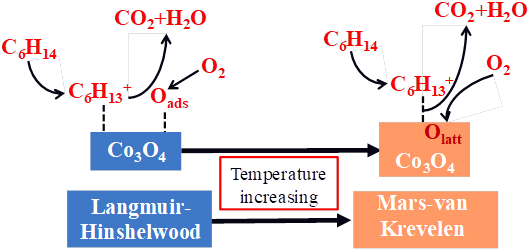近日,广东工业大学环境健康与污染控制研究院、环境科学与工程学院安太成教授团队题为《Interfacial catalytic degradation mechanism of n-hexane over polyhedral Co3O4 nanocatalysts derived from topotactic condensation of ZIF-67,(https://doi.org/10.1039/D4EN00101J)》的学术论文在Environmental Science: Nano (2024, 11, 2000)期刊上接收发表。论文的第一作者为郭云龙副教授,通讯作者为安太成教授。该研究工作主要是通过原位热解诱导过程,使ZIF-67发生拓扑缩合,进而生成多面体Co3O4纳米催化剂,所制备的催化剂在催化降解正己烷时表现出了优异的催化活性和稳定性;通过原位红外实验阐述了正己烷在催化剂上的界面催化降解机理。该研究工作可为大气环境领域中非贵金属催化剂的研发及其典型VOCs的高效消除提供了新的研究方法和思路。

第一作者: 郭云龙 副教授
通讯作者: 安太成 教授
通讯单位: 广东工业大学
论文DOI: https://doi.org/10.1039/D4EN00101J
研究挥发性有机物(VOCs)在具有多面体结构和各向异性性质的纳米结构金属氧化物催化剂上的高效催化降解具有重要的意义。本研究通过原位热解诱导过程,使沸石咪唑骨架材料(ZIF-67)发生拓扑缩合,最终生成多面体Co3O4纳米结构催化剂。研究发现该缩合过程不会改变ZIF-67前驱体的拓扑结构。300 oC拓扑缩合得到的最佳Co3O4-300催化剂对催化消除正己烷表现出优异的催化活性,其T90为196 oC (60 000 mL g-1 h-1),优于商业化的Pt/Al2O3。更重要的是,该催化剂具有优异的循环稳定性、较好的催化稳定性和较强的抗水汽和二氧化碳脱附能力。该衍生制备的金属氧化物催化剂优异的催化性能可归因于催化剂的拓扑多面体形貌以及丰富的酸性位点和氧空位的调控。此外,还通过原位DRIFTS表征阐明了Co3O4-300催化消除正己烷的界面催化降解机理,揭示了其降解机理是从L-H模型到MvK模型的渐进反应机制。该研究工作可为MOFs材料拓扑缩合合成非贵金属催化剂以及大气中直链烷烃的高效消除提供新研究方法和思路。
论文网址:https://doi.org/10.1039/D4EN00101J
图片摘要:

英文摘要:
The development of efficient catalytic degradation of volatile organic compounds (VOCs) over nanostructured metal oxide catalysts with a polyhedral structure and anisotropic texture is in demand. Herein, a one-pot and scalable method is reported to synthesize polyhedral Co3O4 nanostructured catalysts, which are involved in topotactic condensation of zeolitic imidazolate framework-67 (ZIF-67) through a pyrolysis-induced procedure. This condensation does not alter the topology of ZIF-67 precursors, thus it can be regarded as topotactic. The optimally prepared Co3O4-300 derived from ZIF-67 shows high catalytic performance for n-hexane oxidation with a T90 of 196 °C at a gas hourly space velocity (GHSV) of 60 000 mL g-1 h-1, superior to commercial Pt/Al2O3. In addition, this catalyst also demonstrates satisfactory catalytic stability after five successive cycles of heating–cooling tests, excellent long-term durability after 90 h of on-stream reaction and strong resistance to water vapor and CO2. Experimental results indicate that the topotactic polyhedral morphology, abundant acid sites and oxygen vacancies are beneficial for n-hexane oxidation. The interfacial catalytic degradation mechanism of n-hexane over Co3O4 nanocatalysts could be explained by a progressive transition from the Langmuir–Hinshelwood (L–H) model to Mars–van Krevelen (MvK) model. This work may provide a new strategy for rational design and synthesis of metal oxide nanocatalysts enabled by topotactic condensation of metal organic frameworks for catalytic degradation of typical VOCs in real environments.
资助项目:该研究工作得到了国家自然科学基金(42377221, 42007192, 42077332, 42377099和42007315),广东省基础与应用基础研究项目(2022A1515011947, 2022A1515011465和2024A1515030144),广东省重点研发计划项目(2019B110206002),广东省本土创新团队项目(2017BT01Z032)等项目的支持。